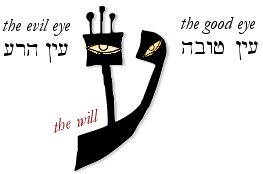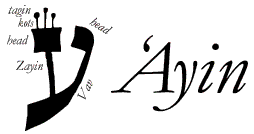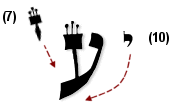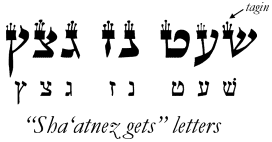|
- The Meaning of Ayin
The word Ayin  means “eye,” “to see,” and by extension, to understand and obey (see Jer. 5:21, Isa. 6:10, Matt. 13:15, etc.). Ayin further represents the primeval light, that is, the spiritual light of God mentioned in Gen. 1:3 (in distinction to celestial lights mentioned in Gen. 1:14-18). According to Jewish midrash, this divine light is far greater than the light that emanates from the sun and stars. Though concealed in the Torah, the spiritual eye can behold the presence of this radiance, but only by means of inner eye given by the Ruach HaKodesh. means “eye,” “to see,” and by extension, to understand and obey (see Jer. 5:21, Isa. 6:10, Matt. 13:15, etc.). Ayin further represents the primeval light, that is, the spiritual light of God mentioned in Gen. 1:3 (in distinction to celestial lights mentioned in Gen. 1:14-18). According to Jewish midrash, this divine light is far greater than the light that emanates from the sun and stars. Though concealed in the Torah, the spiritual eye can behold the presence of this radiance, but only by means of inner eye given by the Ruach HaKodesh.
- Allegories of Ayin
Ayin is sometimes described as having two eyes that connect to a common “optic nerve” that leads to the brain. The two eyes represent choice or the actions of the will (i.e., the heart). We can choose whether to use the good eye or the evil eye to perceive things; we can choose to see the glass as half full rather than half empty.
Ayin (like the letter Aleph) is a silent letter. It is said that Ayin “sees” but does not speak, and therefore represents the attitude of humility (or anavah). Anavah begins with an Ayin, as does the word for service (avodah) and yoke (ol). On the other hand, Ayin can represent idolatry (avodah zara) as well as slavery (avedut), both of which are born out of the heart of envy.
When the eye is evil (ayin ra), it becomes a slave to the purposes of sin and the yetzer hara (the evil impulse). As Rashi said, “The heart and the eyes are the spies of the body: they lead a person to transgress; the eyes see, the heart covets, and the body transgresses (Bamidbar 15.39).

A person is said to be olam katan, a minature world. The eye reflects the world outside and reveals the world inside. A person’s outlook reveals their inner character. This is part of what Jesus meant when He said, “The eye is the light of the body. So, if your eye is healthy, your whole body will be full of light, but if your eye is evil, your whole body will be full of darkness. If then the light in you is darkness, how great is the darkness!” (Matt. 6:22-23).
According to the Talmud (Shabbat 104a), the good eye of Ayin looks toward Samekh in the alphabet and stands for the acronym semokh (“support”) anaiyim (“the poor”). That is, the ayin tovah (“good eye”) will manifest itself in benevolence and charity toward others. On the other hand, the ayin hara (“evil eye”) will look to the letter Pey (mouth), considering how it might consume for itself in greed and envy.
- The Gematria of Ayin
The letter Ayin can be represented as the number 16 (from its ordinal position within the Alphabet), as 17 (from its component values of Yod (10) and Zayin (7)); as 70 (from its number within the alphabet), as 130 (from its plenary spelling: Ayin (70), Yod (10), and Nun (50)), and so on. The value 130 is thought to be suggestive of the ladder (selum) of Sinai, both words which equal 130, which suggests that the spiritual eye sees the Torah as the means of approaching God.
Of particular interest, however, is the number 70, since it occurs frequently within Scripture and Jewish tradition. In Scripture we read that 70 souls went into Egypt, 70 elders of Israel saw the God of Israel on Mt. Sinai, 70 sacrifices made for the nations (during the festival of Sukkot), and Israel was subject to 70 years of exile in Babylon. In Jewish tradition, there are 70 members of the Sanhedrin, 70 words of Kaddish, 70 “faces of Torah,” 70 Names of God, and 70 birth pangs until the coming of the Mashiach.
- The Eye(s) of the LORD
In the Scriptures, God’s intimate knowledge of our lives is sometimes referred to as the “Eye of the Lord.” Adonai’s eyes are in every place, observing both the good and evil (Prov. 15:3). [This is sometimes referred to as hashgachah.] The LORD’s eyes focus throughout the whole earth to defend the righteous (2 Chr. 16:9) and to sustain and deliver those who are hoping in His chesed (faithful mercy). |










